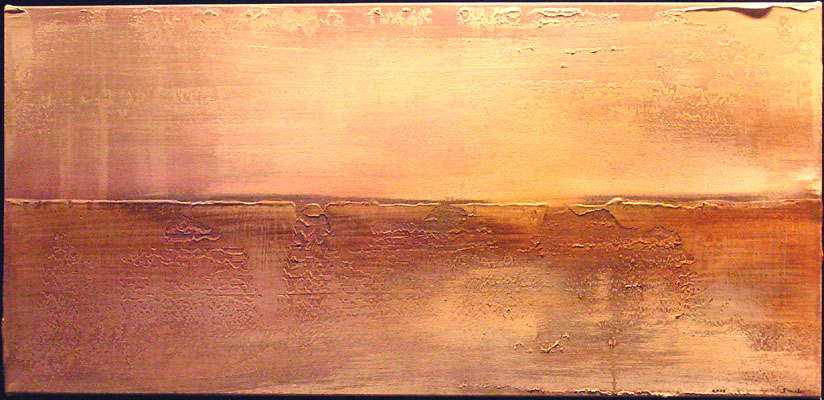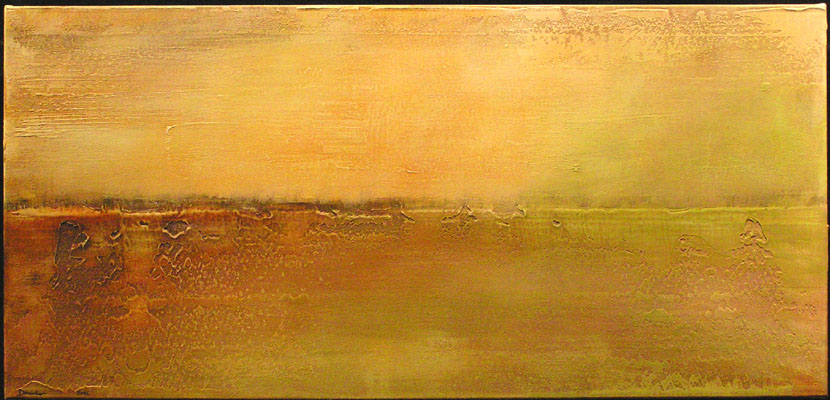
|
home |
bio |
contact |
color |
copyright |
links |
|---|
My work draws largely from two artistic wells, one the vast tradition of nature painting from China and Japan, the other the religious painting and sculpture of pre-Rennaissance and ancient Europe. From the east I borrow some of the forms and techniques of scroll and screen painting, as well as a devotion to nature as my subject. While traditional eastern painting usually conveys feelings of serenity and harmony, the emotion more aspired to in my own work is that of awe or wonder in the presence of nature's inherent divinity. This feeling, of religious awe, is more akin to the traditional purposes of art developed in Europe.
The materials and form of the work consciously evoke the synthesis of these two traditions. I work with both ink and paint, applied in textured and transparent layers, in a style which borrows elements of Asian inkbrush painting, ancient frieze bas-relief, antique fresco, and western panel painting. Many pieces are multi-panel (diptychs or triptychs). This to me creates a sense of the painting as a religious or devotional object (a diptych is formed by the closed doors of an altarpiece; when opened the inner panel surfaces reveal a triptych.) In this way the structure of the painting emphasizes its role as a devotional object, addressed to the divinity of the natural world.

The multi-panel form, especially when combined with elongated dimensions, also serves to produce a visually narrative landscape, one which is not taken in at a single glance but requires movement of the eye. This is a quality of both multi-panel screen painting (where the movement is horizontal) and scroll painting (where the movement is vertical) used in China and Japan, and I believe more accurately recreates the way we naturally view the world before us.

Yet to view this work as any kind of conscious attempt to synthesize eastern and western traditions would be to put the cart before the horse. The work flows naturally out of my own deep awe of nature, and in this way owes as much to my adopted home in the Pacific Northwest as to any traditions that I bring to it. I began painting shortly after coming to live in Seattle. Educated in mathematics and engineering, and working as a research scientist, my transformation as a painter was catalyzed by a number of events in my life at that time. In 1986 I had a conversation with Northwest artist Kenneth Callahan which deeply impressed me and which began to open my eyes to the parallels of art and mathematics. I began then to study art history, but did not begin to make art until the winter of 1989, when I was in the Arctic Ocean on a research expedition. Living amid the sea ice and perpetual darkness, I began to use art to counter the visual starvation of the polar winter. Even these early works were devoted to nature- I painted polar bears and darkness, both avatars of fear, awe, and mystery. By making these fearsome images into art, I found, their divine natures were revealed, and they became spiritual guides. I felt that perhaps I had discovered the ancient purpose of art.
The power of art to render elements of the world around us as objects of devotion is its most potent quality. In this way making art is like dreaming. We find the meaning of things through an exploration of the unconscious. An object which carried fear may become a totem, a protector. In my work birds have been prominent- are these spirits which fly above our world and connect us to heaven? The wild grasses and marsh plants that inhabit much of my current work come from the coastal landscape of the northwest United States and Canada and are images that are persistent and compelling to me. By painting these images repeatedly, I begin to see them as something holy, almost a deity. I don't know why this is. Grasses are the wild predecessors of all of the cultivated grains: wheat, from which we make bread, the holiest substance of European civilization; corn, which was sacred to the indigenous peoples of America; and rice, which is synonymous with life throughout Asia. Could this be what I find so compelling in these images? Or could it be the suggestions of salt and water, the continuity of the wet earth and our own cellular essence? I don't know the answers to these questions, but it is clear that for me there is a deep holiness in the world, omnipresent in the landscape.
